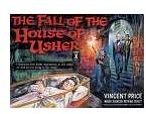Edgar Allan Poe's The Fall of the House of Usher Analysis and Symbolism
Analysis
We’ll begin our Edgar Allan Poe House of Usher analysis with an overview of the story’s main elements. If you haven’t read Poe’s House of Usher yet, take a look at PoeStories.com.
[caption id=“attachment_130812” align=“aligncenter” width=“512”] Poe around 1849[/caption]
Poe around 1849[/caption]
- Setting and Mood - the story’s central feature is its ominous mood established by its dreary setting. The story’s opening packs a gloomy punch: “During the whole of a dull, dark, and soundless day in the autumn of the year, when the clouds hung oppressively low in the heavens, I had been passing alone, on horseback, through a singularly dreary tract of country; and at length found myself, as the shades of the evening drew on, within view of the melancholy House of Usher.” The house’s melancholy surroundings are matched by the mansion’s interior, highlighted by labyrinthine hallways, claustrophobic rooms, and a tomb in the basement. The paintings on the wall and books on the shelf contribute to the mansion’s Gothic feel.
- Word Choice - Poe establishes the mood with specific word choice (some examples are highlighted in the above passage and in the passage that follows): “There was an iciness, a sinking, a sickening of the heart—an unredeemed dreariness of thought which no goading of the imagination could torture into aught of the sublime. What was it—I paused to think—what was it that so unnerved me in the contemplation of the House of Usher?”
- Sound Devices - Poe uses alliteration and consonance along with words derived from Anglo-Saxon to create harshness in the setting: dull and dark; tract of country, sinking and sickening, unredeemed dreariness, and many more (for more on alliteration and sound devices, follow the links).
- Characters - All three characters suffer from madness and gloom, more than likely brought on by the gloominess of the setting.
- American Romanticism - Poe’s fascination with death and the supernatural permeates the story.
Symbolism
Next, we will talk about Edgar Allan Poe House of Usher symbolism. Most of the symbolism in “The Fall of the House of Usher” is internal.
- The House of Usher refers to both the house and the family.
- The ghastly images inside the house symbolize the madness of the house’s inhabitants. The Gothic literature and stories of strange goings-on represent the inhabitants’ thoughts.
- The fungi and physical deterioration of the house symbolizes the physical deterioration of Roderick and Madeline.
- The upside down reflection of the house in the tarn symbolizes the upside down thinking of the Ushers. The bridge over the tarn symbolizes the narrator who serves as the only bridge to the outside world.
- The collapsing of the house straight down into the tarn symbolizes the linear fashion of the Usher’s family tree and its ultimate collapse.
- The rank atmosphere in “The Fall of the House of Usher” symbolizes the negative effect of being in the Usher’s presence.
Explanations: The Atmosphere
It is plausible that Roderick’s sickness is a result of the atmosphere surrounding the house of Usher. The following quotes demonstrate the sick atmosphere:
- “I looked upon the scene before me—upon the mere house, and the simple landscape features of the domain—upon the bleak walls—upon the vacant eye-like windows—upon a few rank sedges—and upon a few white trunks of decayed trees.”
- “I reined my horse to the precipitous brink of a black and lurid tarn that lay in unruffled luster by the dwelling, and gazed down”
- “an atmosphere which had no affinity with the air of heaven, but which had reeked up from the decayed trees, and the gray wall, and the silent tarn—a pestilent and mystic vapor, dull, sluggish, faintly discernible, and leaden-hued.”
- “I felt that I breathed an atmosphere of sorrow. An air of stern, deep, and irredeemable gloom hung over and pervaded all.”
- “the many fungi which overspread them, and of the decayed trees which stood around—above all, in the long-undisturbed endurance of this arrangement, and in its reduplication in the still waters of the tarn. Its evidence—the evidence of the sentience—was to be seen, he said (and I here started as he spoke), in the gradual yet certain condensation of an atmosphere of their own about the waters and the walls.”
- “the rank miasma of the tarn”
For an analysis and explanation of these quotes regarding atmosphere in “The Fall of the House of Usher,” check out “Themes and Interpretations in “The Fall of the House of Usher” linked below.
This post is part of the series: Short Story Study Guides, Part III
Your teachers assign short stories. You read short stories. You come here for short story summaries and analysis. You discuss short stories in class. Your teacher gives you an ‘A’.
